Velaquez (or Velaquez), Diego
Las Meninas (Maids of Honor)
1656-57 (120 Kb); Museo del Prado, Madrid
스페인바로크의 거장 디에고 벨라스케스 의 작품.
'시녀들' 이라는 제목으로 알려진 이 그림에 나오는 인물들은 모두 신원 확인 되어 있다.
안녕 난, 디에고 벨라스케스. 스페인 출신 화가란다, 또다른 훌륭한 스페인 작가로는 피카소가 있지.
왼쪽에서 오른쪽으로...
도냐 마리아 아우구스티나 데 사르미엔토 , 마르가리타 공주, 도냐 이사벨 데 벨라스코 (마리아와 함께 어린 공주의 시녀),
난장이 마리바르볼라, 개 닥스훈트, 개위에 왼발을 얹어 놓고 있는 니콜라시토 페르투사토
오른쪽 두사람은 왕비의 시녀들의 수행원인 도냐 마르셀라 데 우요아, 돈 디에고 루이스 데아스코나
배경에 열린문에 걸터 서 있는 사람은 왕실의 시종 돈 호세 니에토 벨라스케스(아마도 화가의 친척으로 짐작)
문 옆의 거울에는 마리아나 왕비와 국왕 펠립페4세의 비친 모습이 들어 있다. 거울위에 있는 두 그림은 신화적 장면을 묘사한 델 마소의 작품으로 짐작되는데, 루벤스의 작품을 본뜬 <팔라스와 아라크네>, 야콥 요르단스의 작품을 본뜬 <아폴로와 마르시아스> 이다.
디에고 벨라스케스(1599~1660)는 스페인의 위대한 화가이며 모든 시대를 통틀어 가장 최고의 예술가이다. 벨라스케스만의 기법과 독창적인 스타일은 다른 어떤 화가들보다 더 유럽 예술가들에게 지대한 영향을 끼쳤다.
Vel?quez (or Vel?quez), Diego (1599-1660). Spain's greatest painter was also one of the supreme artists of all time. A master of technique, highly individual in style, Diego Velasquez may have had a greater influence on European art than any other painter.
Diego Rodriguez de Silva Velasquez was born in Seville, Spain, presumably shortly before his baptism on June 6, 1599. His father was of noble Portuguese descent. In his teens he studied art with Francisco Pacheco, whose daughter he married. The young Velasquez once declared, "I would rather be the first painter of common things than second in higher art." He learned much from studying nature. After his marriage at the age of 19, Velasquez went to Madrid. When he was 24 he painted a portrait of Philip IV, who became his patron.
The artist made two visits to Italy. On his first, in 1629, he copied masterpieces in Venice and Rome. He returned to Italy 20 years later and bought many paintings--by Titian, Tintoretto, and Paolo Veronese--and statuary for the king's collection.
Except for these journeys Velasquez lived in Madrid as court painter. His paintings include landscapes, mythological and religious subjects, and scenes from common life, called genre pictures. Most of them, however, are portraits of court notables that rank with the portraits painted by Titian and Anthony Van Dyck.
Duties of Velasquez' royal offices also occupied his time. He was eventually made marshal of the royal household, and as such he was responsible for the royal quarters and for planning ceremonies.
In 1660 Velasquez had charge of his last and greatest ceremony--the wedding of the Infanta Maria Theresa to Louis XIV of France. This was a most elaborate affair. Worn out from these labors, Velasquez contracted a fever from which he died on August 6.
Velasquez was called the "noblest and most commanding man among the artists of his country." He was a master realist, and no painter has surpassed him in the ability to seize essential features and fix them on canvas with a few broad, sure strokes. "His men and women seem to breathe," it has been said; "his horses are full of action and his dogs of life."
Because of Velasquez' great skill in merging color, light, space, rhythm of line, and mass in such a way that all have equal value, he was known as "the painter's painter." Ever since he taught Bartolom?Murillo, Velasquez has directly or indirectly led painters to make original contributions to the development of art. Others who have been noticeably influenced by him are Francisco de Goya, Camille Corot, Gustave Courbet, Edouard Manet, and James McNeill Whistler. His famous paintings include The Surrender of Breda, an equestrian portrait of Philip IV, The Spinners, The Maids of Honor, Pope Innocent X, Christ at Emmaus, and a portrait of the Infanta Maria Theresa
Velázquez (or Velásquez), Diego (1599-1660). Spain's greatest painter was also one of the supreme artists of all time. A master of technique, highly individual in style, Diego Velasquez may have had a greater influence on European art than any other painter.
Diego Rodriguez de Silva Velasquez was born in Seville, Spain, presumably shortly before his baptism on June 6, 1599. His father was of noble Portuguese descent. In his teens he studied art with Francisco Pacheco, whose daughter he married. The young Velasquez once declared, "I would rather be the first painter of common things than second in higher art." He learned much from studying nature. After his marriage at the age of 19, Velasquez went to Madrid. When he was 24 he painted a portrait of Philip IV, who became his patron.
The artist made two visits to Italy. On his first, in 1629, he copied masterpieces in Venice and Rome. He returned to Italy 20 years later and bought many paintings--by Titian, Tintoretto, and Paolo Veronese--and statuary for the king's collection.
Except for these journeys Velasquez lived in Madrid as court painter. His paintings include landscapes, mythological and religious subjects, and scenes from common life, called genre pictures. Most of them, however, are portraits of court notables that rank with the portraits painted by Titian and Anthony Van Dyck.
Duties of Velasquez' royal offices also occupied his time. He was eventually made marshal of the royal household, and as such he was responsible for the royal quarters and for planning ceremonies.
In 1660 Velasquez had charge of his last and greatest ceremony--the wedding of the Infanta Maria Theresa to Louis XIV of France. This was a most elaborate affair. Worn out from these labors, Velasquez contracted a fever from which he died on August 6.
Velasquez was called the "noblest and most commanding man among the artists of his country." He was a master realist, and no painter has surpassed him in the ability to seize essential features and fix them on canvas with a few broad, sure strokes. "His men and women seem to breathe," it has been said; "his horses are full of action and his dogs of life."
Because of Velasquez' great skill in merging color, light, space, rhythm of line, and mass in such a way that all have equal value, he was known as "the painter's painter." Ever since he taught Bartolomé Murillo, Velasquez has directly or indirectly led painters to make original contributions to the development of art. Others who have been noticeably influenced by him are Francisco de Goya, Camille Corot, Gustave Courbet, Edouard Manet, and James McNeill Whistler. His famous paintings include The Surrender of Breda, an equestrian portrait of Philip IV, The Spinners, The Maids of Honor, Pope Innocent X, Christ at Emmaus, and a portrait of the Infanta Maria Theresa.
Las Meninas (Maids of Honor)
1656-57 (120 Kb); Museo del Prado, Madrid
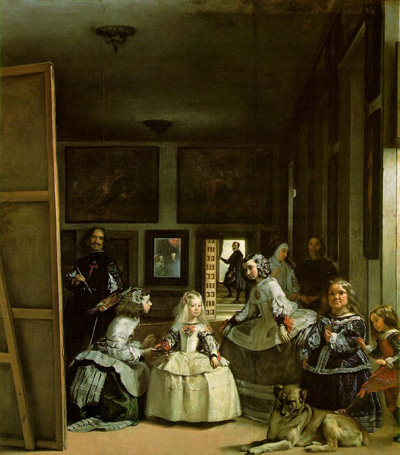
스페인바로크의 거장 디에고 벨라스케스 의 작품.
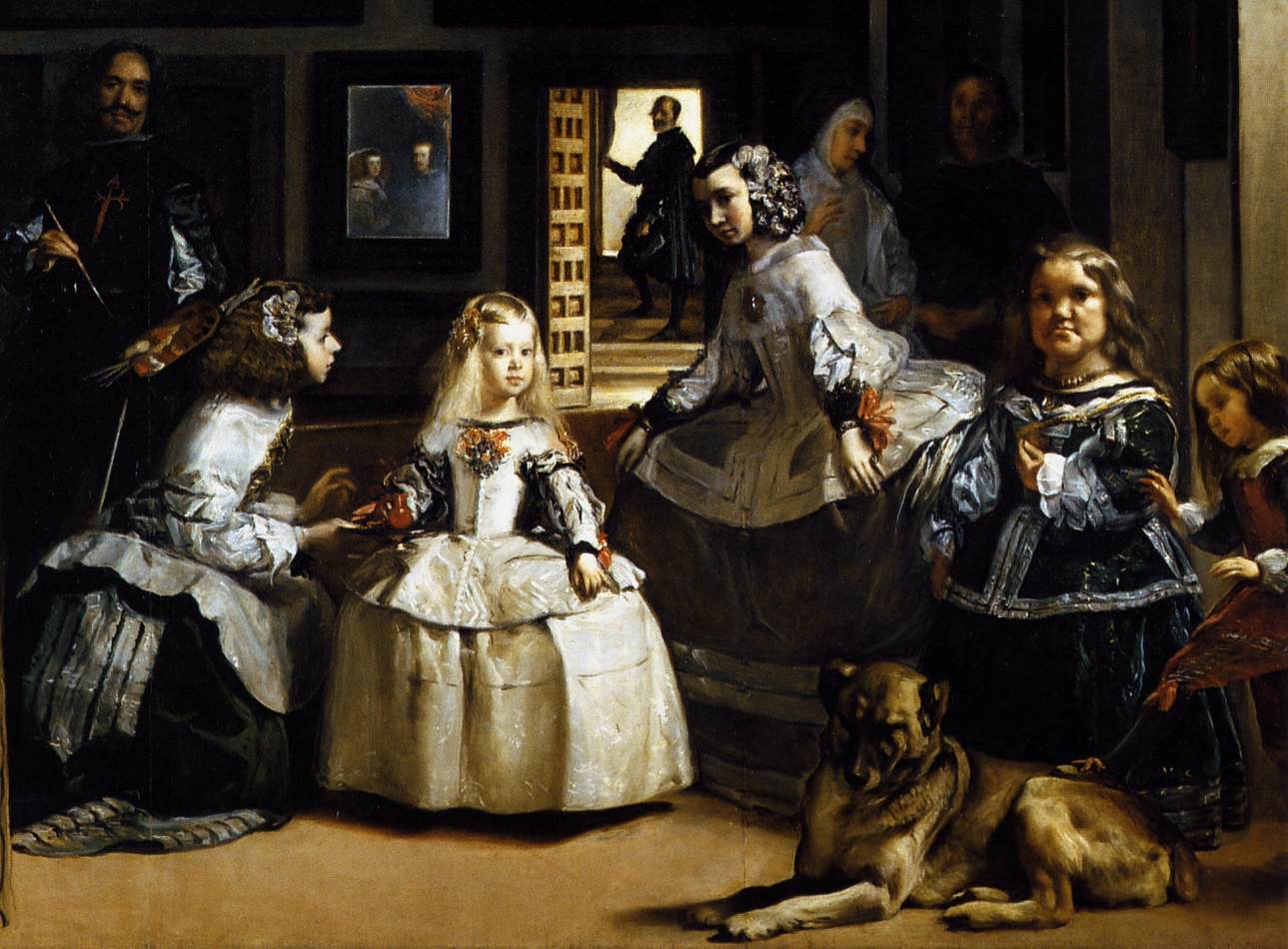
'시녀들' 이라는 제목으로 알려진 이 그림에 나오는 인물들은 모두 신원 확인 되어 있다.
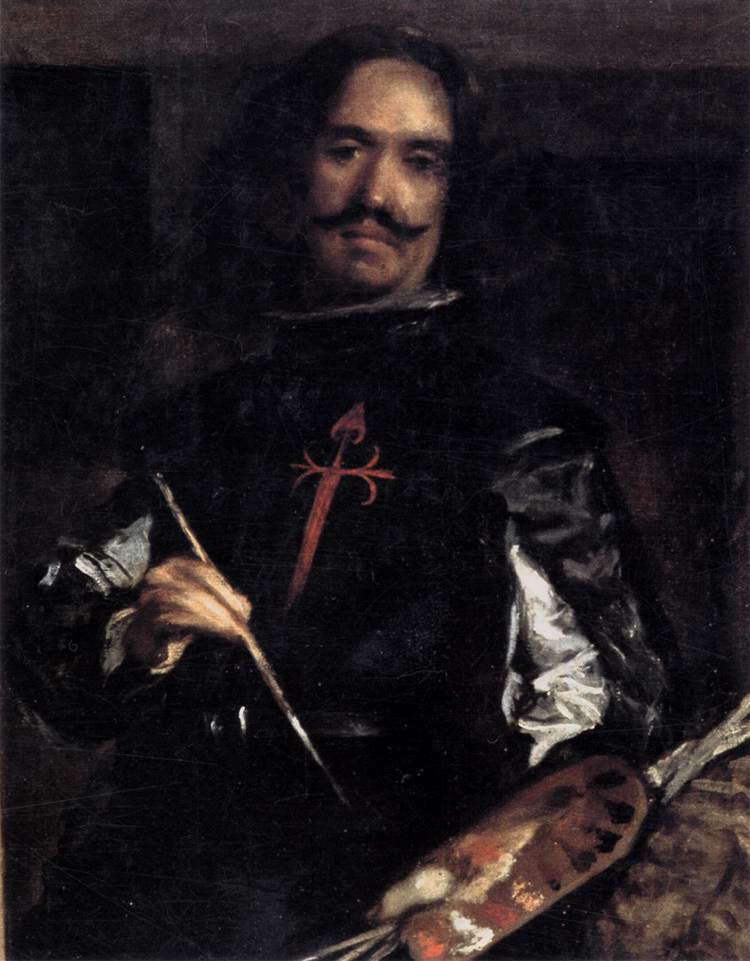
안녕 난, 디에고 벨라스케스. 스페인 출신 화가란다, 또다른 훌륭한 스페인 작가로는 피카소가 있지.
왼쪽에서 오른쪽으로...
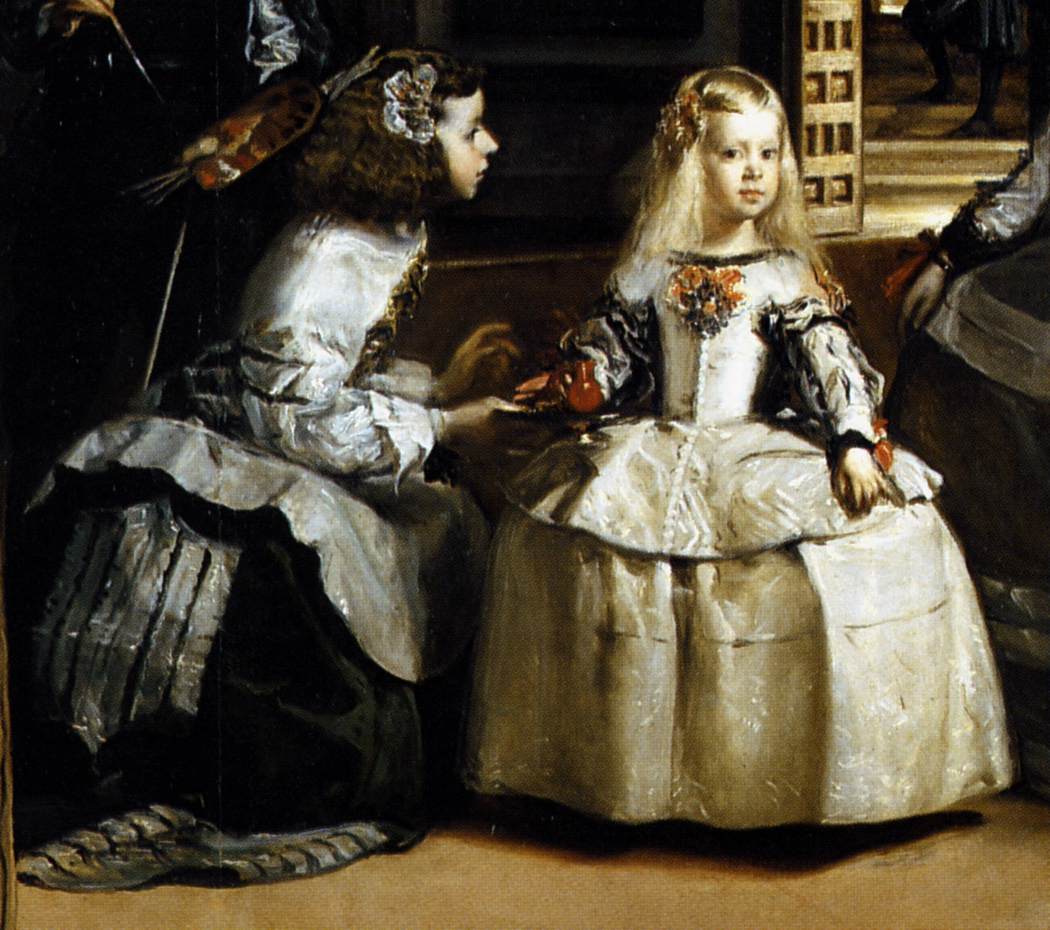
도냐 마리아 아우구스티나 데 사르미엔토 , 마르가리타 공주, 도냐 이사벨 데 벨라스코 (마리아와 함께 어린 공주의 시녀),
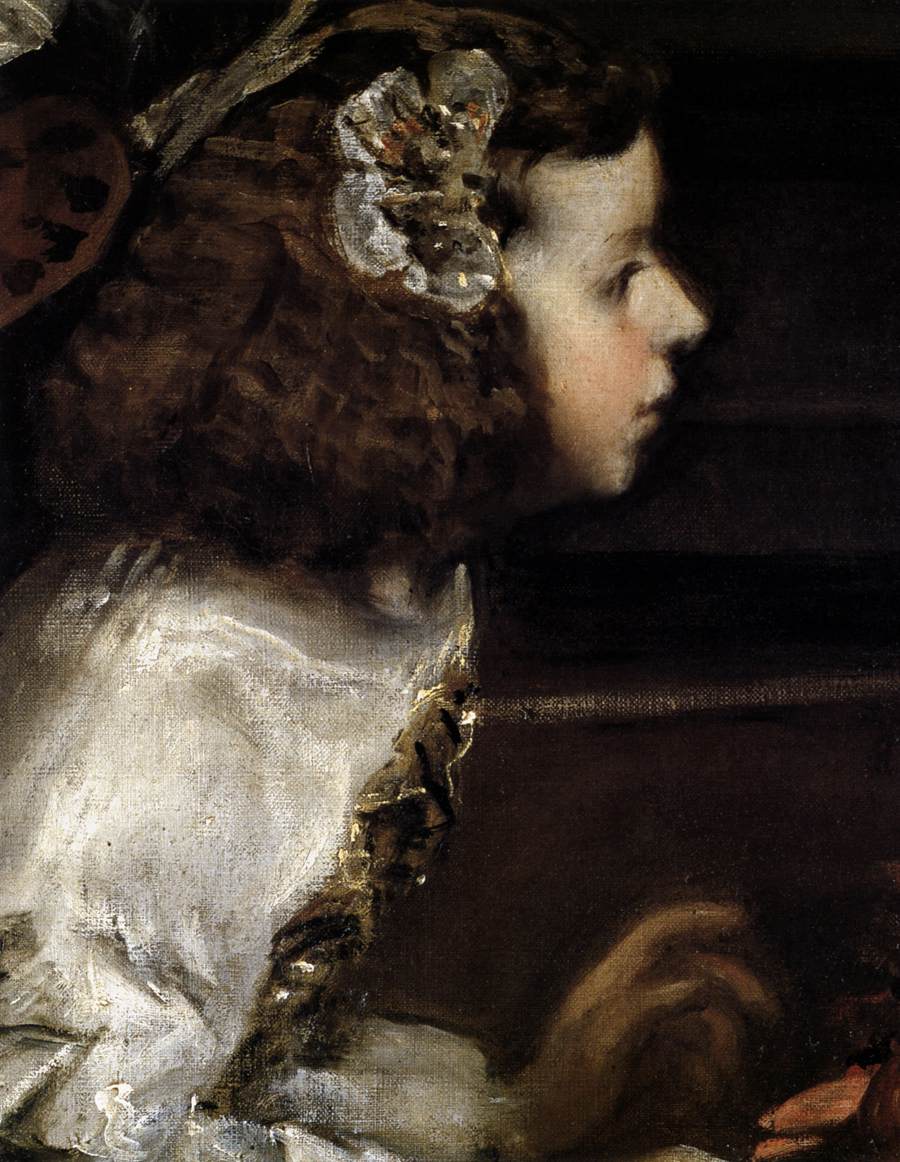
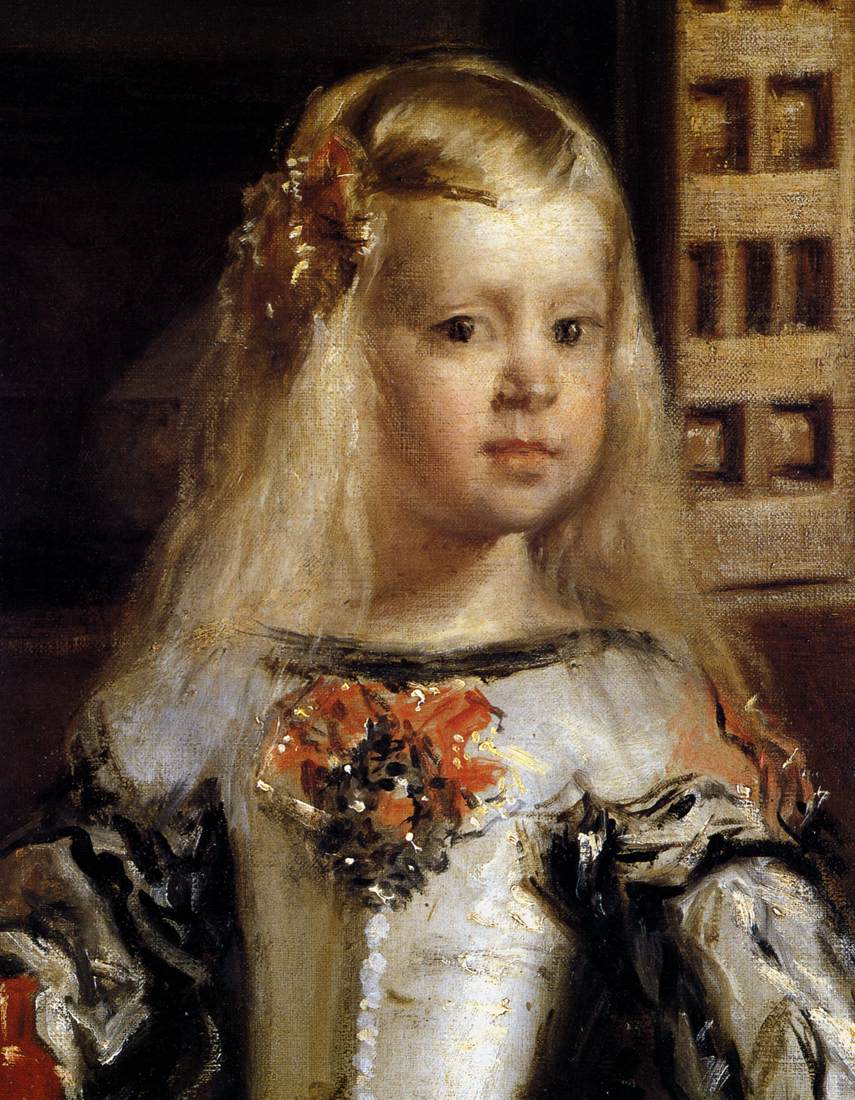
난장이 마리바르볼라, 개 닥스훈트, 개위에 왼발을 얹어 놓고 있는 니콜라시토 페르투사토
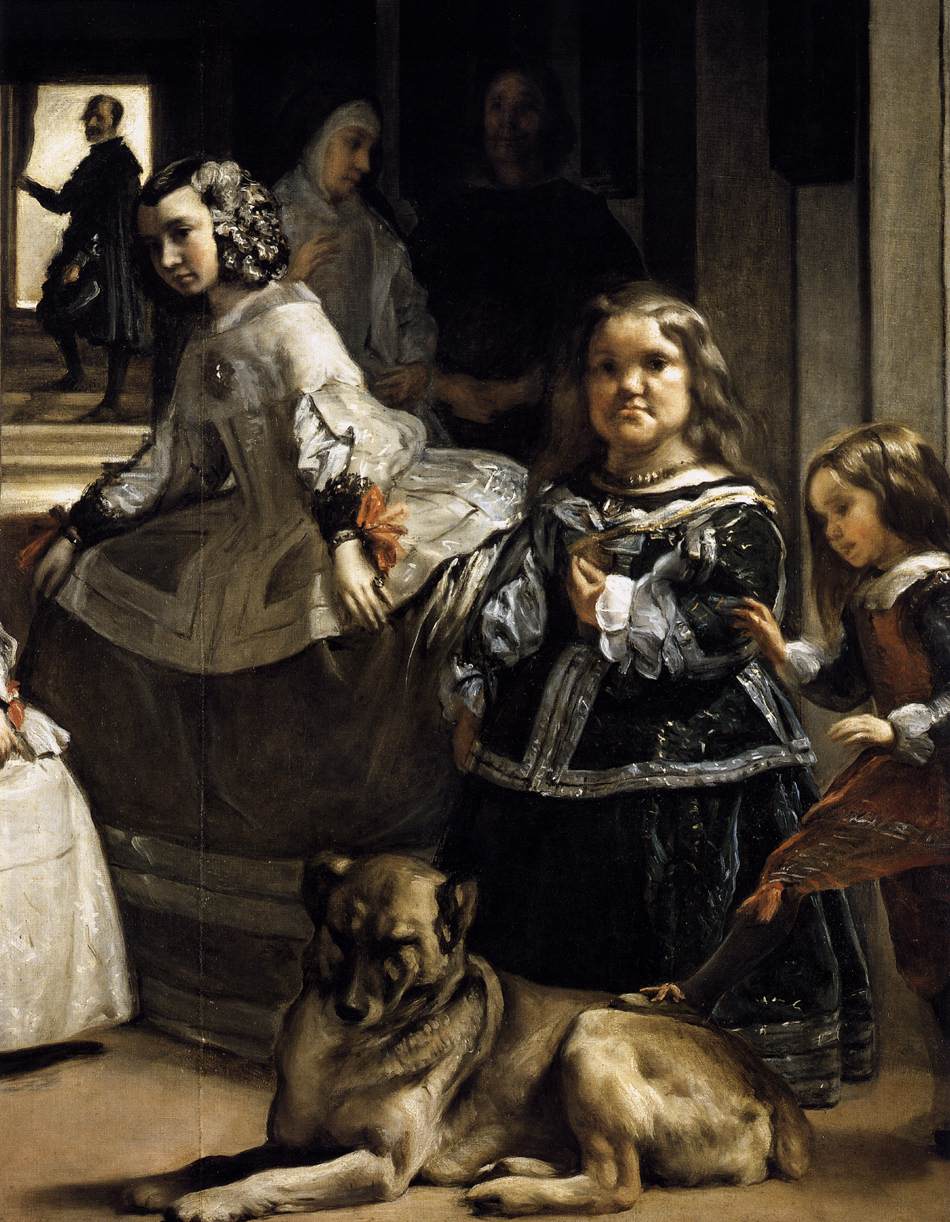
오른쪽 두사람은 왕비의 시녀들의 수행원인 도냐 마르셀라 데 우요아, 돈 디에고 루이스 데아스코나
배경에 열린문에 걸터 서 있는 사람은 왕실의 시종 돈 호세 니에토 벨라스케스(아마도 화가의 친척으로 짐작)
문 옆의 거울에는 마리아나 왕비와 국왕 펠립페4세의 비친 모습이 들어 있다. 거울위에 있는 두 그림은 신화적 장면을 묘사한 델 마소의 작품으로 짐작되는데, 루벤스의 작품을 본뜬 <팔라스와 아라크네>, 야콥 요르단스의 작품을 본뜬 <아폴로와 마르시아스> 이다.
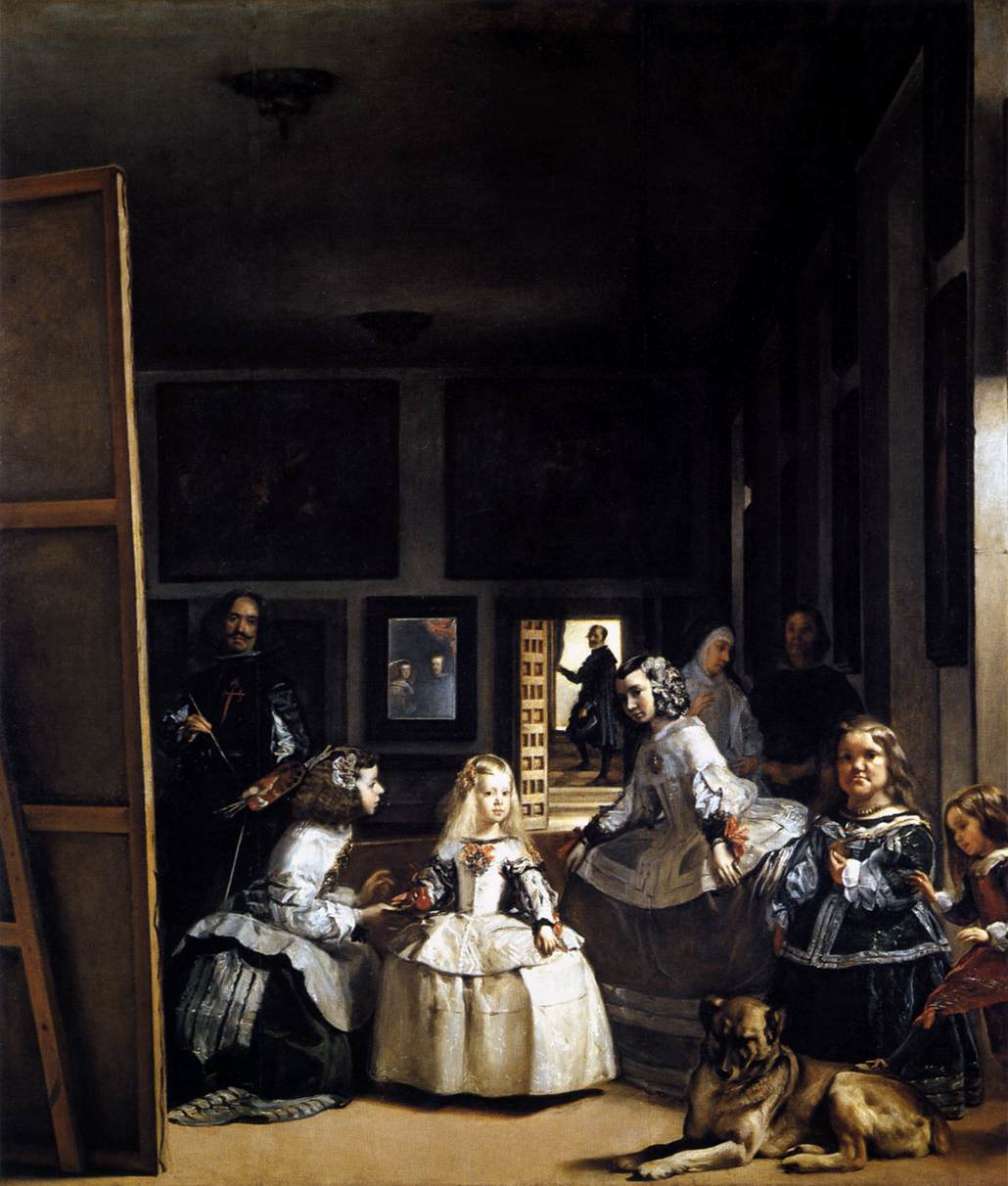
디에고 벨라스케스(1599~1660)는 스페인의 위대한 화가이며 모든 시대를 통틀어 가장 최고의 예술가이다. 벨라스케스만의 기법과 독창적인 스타일은 다른 어떤 화가들보다 더 유럽 예술가들에게 지대한 영향을 끼쳤다.
벨라스케스는 1599년 6월 6일 스페인 세빌레에서 태어났다. 그의 아버지는 포르투갈 귀족 혈통이었다. 그는 십대에 프란시스코 파체오에게서 예술을 배웠으며 그의 딸과 결혼하였다.어린 벨라스케스는 한 때 “나는 고급예술의 두 번째보다는 평범한 일상에서의 최고 화가가 되는 게 낮다”고 공표하였었다. 그는 자연으로부터 많은 것을 배웠다. 19세에 그의 결혼 후 벨라스케스는 마드리드로 그가 24살 때 그의 후원자 Philip IV의 초상화를 그렸다.
그는 이태리를 2번 방문하였다. 첫 번째는 1629년 베니스와 로마에서 거장들의 작품을 카피하기 위해서였다. 그가 이태리에서 돌아온 후 20살 때, 많은 그림들을 샀다. 틴티안 틴토레토, 파올로 베로니스,
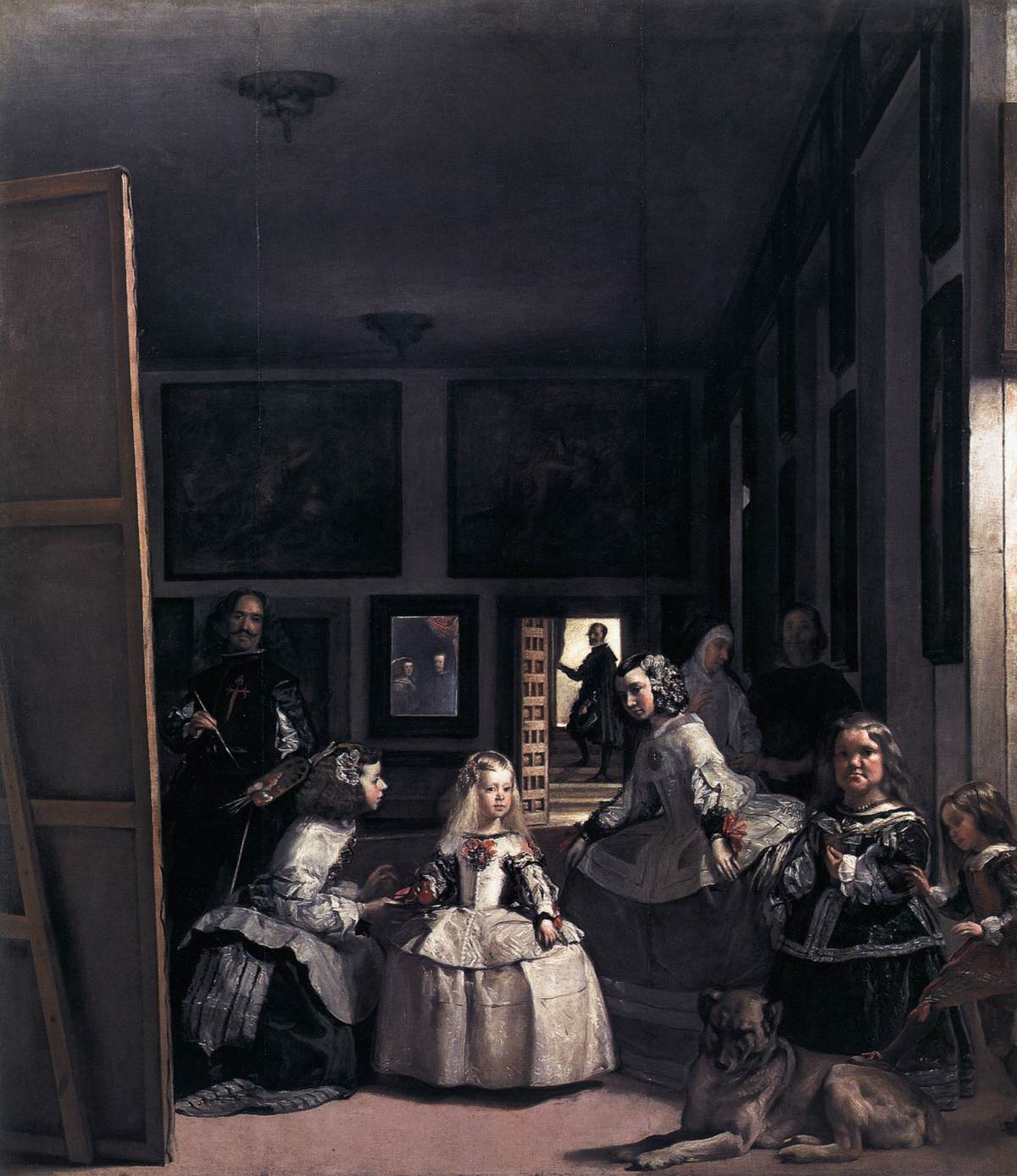
Vel?quez (or Vel?quez), Diego (1599-1660). Spain's greatest painter was also one of the supreme artists of all time. A master of technique, highly individual in style, Diego Velasquez may have had a greater influence on European art than any other painter.
Diego Rodriguez de Silva Velasquez was born in Seville, Spain, presumably shortly before his baptism on June 6, 1599. His father was of noble Portuguese descent. In his teens he studied art with Francisco Pacheco, whose daughter he married. The young Velasquez once declared, "I would rather be the first painter of common things than second in higher art." He learned much from studying nature. After his marriage at the age of 19, Velasquez went to Madrid. When he was 24 he painted a portrait of Philip IV, who became his patron.
The artist made two visits to Italy. On his first, in 1629, he copied masterpieces in Venice and Rome. He returned to Italy 20 years later and bought many paintings--by Titian, Tintoretto, and Paolo Veronese--and statuary for the king's collection.
Except for these journeys Velasquez lived in Madrid as court painter. His paintings include landscapes, mythological and religious subjects, and scenes from common life, called genre pictures. Most of them, however, are portraits of court notables that rank with the portraits painted by Titian and Anthony Van Dyck.
Duties of Velasquez' royal offices also occupied his time. He was eventually made marshal of the royal household, and as such he was responsible for the royal quarters and for planning ceremonies.
In 1660 Velasquez had charge of his last and greatest ceremony--the wedding of the Infanta Maria Theresa to Louis XIV of France. This was a most elaborate affair. Worn out from these labors, Velasquez contracted a fever from which he died on August 6.
Velasquez was called the "noblest and most commanding man among the artists of his country." He was a master realist, and no painter has surpassed him in the ability to seize essential features and fix them on canvas with a few broad, sure strokes. "His men and women seem to breathe," it has been said; "his horses are full of action and his dogs of life."
Because of Velasquez' great skill in merging color, light, space, rhythm of line, and mass in such a way that all have equal value, he was known as "the painter's painter." Ever since he taught Bartolom?Murillo, Velasquez has directly or indirectly led painters to make original contributions to the development of art. Others who have been noticeably influenced by him are Francisco de Goya, Camille Corot, Gustave Courbet, Edouard Manet, and James McNeill Whistler. His famous paintings include The Surrender of Breda, an equestrian portrait of Philip IV, The Spinners, The Maids of Honor, Pope Innocent X, Christ at Emmaus, and a portrait of the Infanta Maria Theresa
Velázquez (or Velásquez), Diego (1599-1660). Spain's greatest painter was also one of the supreme artists of all time. A master of technique, highly individual in style, Diego Velasquez may have had a greater influence on European art than any other painter.
Diego Rodriguez de Silva Velasquez was born in Seville, Spain, presumably shortly before his baptism on June 6, 1599. His father was of noble Portuguese descent. In his teens he studied art with Francisco Pacheco, whose daughter he married. The young Velasquez once declared, "I would rather be the first painter of common things than second in higher art." He learned much from studying nature. After his marriage at the age of 19, Velasquez went to Madrid. When he was 24 he painted a portrait of Philip IV, who became his patron.
The artist made two visits to Italy. On his first, in 1629, he copied masterpieces in Venice and Rome. He returned to Italy 20 years later and bought many paintings--by Titian, Tintoretto, and Paolo Veronese--and statuary for the king's collection.
Except for these journeys Velasquez lived in Madrid as court painter. His paintings include landscapes, mythological and religious subjects, and scenes from common life, called genre pictures. Most of them, however, are portraits of court notables that rank with the portraits painted by Titian and Anthony Van Dyck.
Duties of Velasquez' royal offices also occupied his time. He was eventually made marshal of the royal household, and as such he was responsible for the royal quarters and for planning ceremonies.
In 1660 Velasquez had charge of his last and greatest ceremony--the wedding of the Infanta Maria Theresa to Louis XIV of France. This was a most elaborate affair. Worn out from these labors, Velasquez contracted a fever from which he died on August 6.
Velasquez was called the "noblest and most commanding man among the artists of his country." He was a master realist, and no painter has surpassed him in the ability to seize essential features and fix them on canvas with a few broad, sure strokes. "His men and women seem to breathe," it has been said; "his horses are full of action and his dogs of life."
Because of Velasquez' great skill in merging color, light, space, rhythm of line, and mass in such a way that all have equal value, he was known as "the painter's painter." Ever since he taught Bartolomé Murillo, Velasquez has directly or indirectly led painters to make original contributions to the development of art. Others who have been noticeably influenced by him are Francisco de Goya, Camille Corot, Gustave Courbet, Edouard Manet, and James McNeill Whistler. His famous paintings include The Surrender of Breda, an equestrian portrait of Philip IV, The Spinners, The Maids of Honor, Pope Innocent X, Christ at Emmaus, and a portrait of the Infanta Maria Theresa.
'History of Arts > Baroque & Rococo' 카테고리의 다른 글
| 바로크 - Espagne (0) | 2007.10.02 |
|---|---|
| 바로크Baroque (1600-1790)- Pays-Bas (1) | 2007.10.01 |
| 바로크- France (2) | 2007.10.01 |
| 바로크 건축 (3) | 2007.10.01 |
| 매너리즘 (1) | 2007.10.01 |



